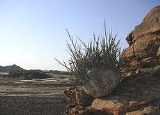
Adenia
Encyclopedia
Adenia is a genus in the passionflower family Passifloraceae. It is named after Aden
, a city in Yemen
.
The genus includes a number of tropical and subtropical xerophytes; many of which form substantially thickened bases or liana
s. It is also a Caudiciform
. Many species are characterised by the extreme toxicity of the sap
. In addition to cyanogenic compounds, these contain lectins which destroy ribosomes, hence prevent protein synthesis. This is the same mode of action as ricin
, and the toxicities are comparable. A. volkensii was shown to be intensely toxic by Barbieri (1984). Pelosi et al. (2005) compared ten species, and found 3 (A. stenodactyla, A. goezii and A. lanceolata) which were inhibitory at <0.1 ng/ml and lethal to mice at <2 ug/kg, making them among the most potent plant toxins known.
Aden
Aden is a seaport city in Yemen, located by the eastern approach to the Red Sea , some 170 kilometres east of Bab-el-Mandeb. Its population is approximately 800,000. Aden's ancient, natural harbour lies in the crater of an extinct volcano which now forms a peninsula, joined to the mainland by a...
, a city in Yemen
Yemen
The Republic of Yemen , commonly known as Yemen , is a country located in the Middle East, occupying the southwestern to southern end of the Arabian Peninsula. It is bordered by Saudi Arabia to the north, the Red Sea to the west, and Oman to the east....
.
The genus includes a number of tropical and subtropical xerophytes; many of which form substantially thickened bases or liana
Liana
A liana is any of various long-stemmed, woody vines that are rooted in the soil at ground level and use trees, as well as other means of vertical support, to climb up to the canopy to get access to well-lit areas of the forest. Lianas are especially characteristic of tropical moist deciduous...
s. It is also a Caudiciform
Caudiciform
Caudiciform plants, or fat plants, are water-retaining plants adapted to arid climate or soil conditions. Caudiciform plants store water in their stem bases, stems and/or roots. Many species of plant from different plant families have developed this form of storing water rather than in foliage or...
. Many species are characterised by the extreme toxicity of the sap
Sap
Sap may refer to:* Plant sap, the fluid transported in xylem cells or phloem sieve tube elements of a plant* Sap , a village in the Dunajská Streda District of Slovakia...
. In addition to cyanogenic compounds, these contain lectins which destroy ribosomes, hence prevent protein synthesis. This is the same mode of action as ricin
Ricin
Ricin , from the castor oil plant Ricinus communis, is a highly toxic, naturally occurring protein. A dose as small as a few grains of salt can kill an adult. The LD50 of ricin is around 22 micrograms per kilogram Ricin , from the castor oil plant Ricinus communis, is a highly toxic, naturally...
, and the toxicities are comparable. A. volkensii was shown to be intensely toxic by Barbieri (1984). Pelosi et al. (2005) compared ten species, and found 3 (A. stenodactyla, A. goezii and A. lanceolata) which were inhibitory at <0.1 ng/ml and lethal to mice at <2 ug/kg, making them among the most potent plant toxins known.
Species and varieties
- Adenia aculeata Engl.
- Adenia cissampeloides (Planch. ex Hook.) Harms
- Adenia cladosepala (Baker) Harms
- Adenia digitata Engl.
- Adenia ellenbeckii Harms
- Adenia firingalavense (Drake ex Jum.) harms
- Adenia formosana Hayata
- Adenia fruticosa
- Adenia glauca Schinz
- Adenia globosa Engl.
- Adenia goetzii
- Adenia gummifera
- Adenia keramanthus Harms.
- Adenia lanceolata
- Adenia lobata (Jacq.) Engl.
- Adenia olaboensis Claverie
- Adenia pechueliiAdenia pechueliiAdenia pechuelii is a species of plant in the Passifloraceae family. It is endemic to Namibia. Its natural habitat is limited to the rocky area between Walvis Bay and southern Kaokoland, where it is still a rare sight and under protection by local law...
Harms - Adenia racemosa
- Adenia spinosa Burtt Davy
- Adenia stenodactyla
- Adenia venenata Forssk.
- Adenia volkensii Harms

